A Report on Organising Personal Work Priorities and Development Needs
VerifiedAdded on 2020/01/23
|7
|1521
|188
Report
AI Summary
This report presents three case studies focusing on organising personal work priorities and development. The first case explores time management challenges, including issues with employee punctuality and goal setting. The report suggests strategies such as setting clear expectations, prioritising tasks, and improving communication. The second case study examines stress management techniques, including workload structuring and stress reduction activities. Finally, the third case highlights the importance of professional development, specifically utilizing presentation and accounting software, and how to enhance skills and knowledge through different opportunities. The report concludes by summarising the key recommendations for effective time management, stress reduction, and professional growth.

Organise personal work priorities
and development
and development
Paraphrase This Document
Need a fresh take? Get an instant paraphrase of this document with our AI Paraphraser
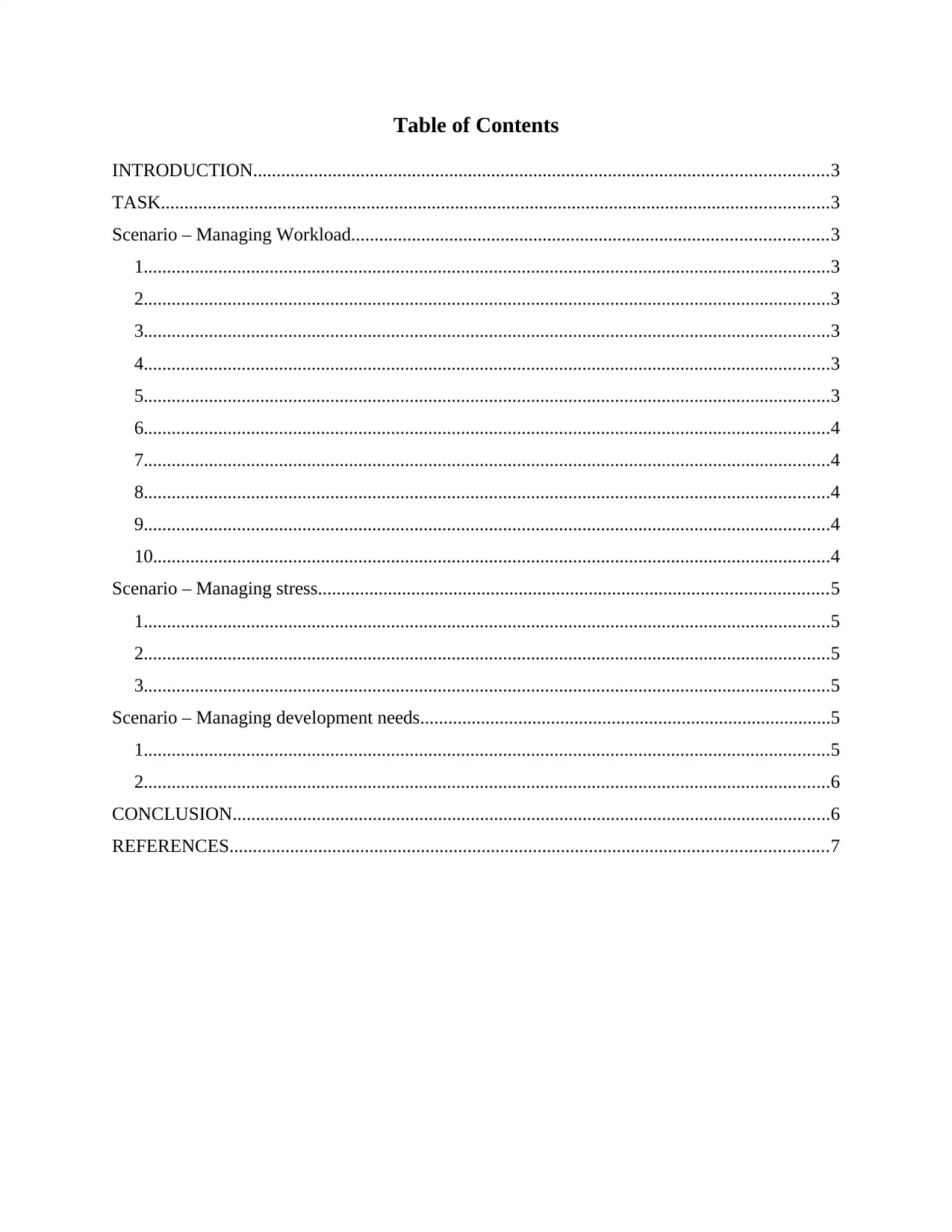
Table of Contents
INTRODUCTION...........................................................................................................................3
TASK...............................................................................................................................................3
Scenario – Managing Workload......................................................................................................3
1...................................................................................................................................................3
2...................................................................................................................................................3
3...................................................................................................................................................3
4...................................................................................................................................................3
5...................................................................................................................................................3
6...................................................................................................................................................4
7...................................................................................................................................................4
8...................................................................................................................................................4
9...................................................................................................................................................4
10.................................................................................................................................................4
Scenario – Managing stress.............................................................................................................5
1...................................................................................................................................................5
2...................................................................................................................................................5
3...................................................................................................................................................5
Scenario – Managing development needs........................................................................................5
1...................................................................................................................................................5
2...................................................................................................................................................6
CONCLUSION................................................................................................................................6
REFERENCES................................................................................................................................7
INTRODUCTION...........................................................................................................................3
TASK...............................................................................................................................................3
Scenario – Managing Workload......................................................................................................3
1...................................................................................................................................................3
2...................................................................................................................................................3
3...................................................................................................................................................3
4...................................................................................................................................................3
5...................................................................................................................................................3
6...................................................................................................................................................4
7...................................................................................................................................................4
8...................................................................................................................................................4
9...................................................................................................................................................4
10.................................................................................................................................................4
Scenario – Managing stress.............................................................................................................5
1...................................................................................................................................................5
2...................................................................................................................................................5
3...................................................................................................................................................5
Scenario – Managing development needs........................................................................................5
1...................................................................................................................................................5
2...................................................................................................................................................6
CONCLUSION................................................................................................................................6
REFERENCES................................................................................................................................7
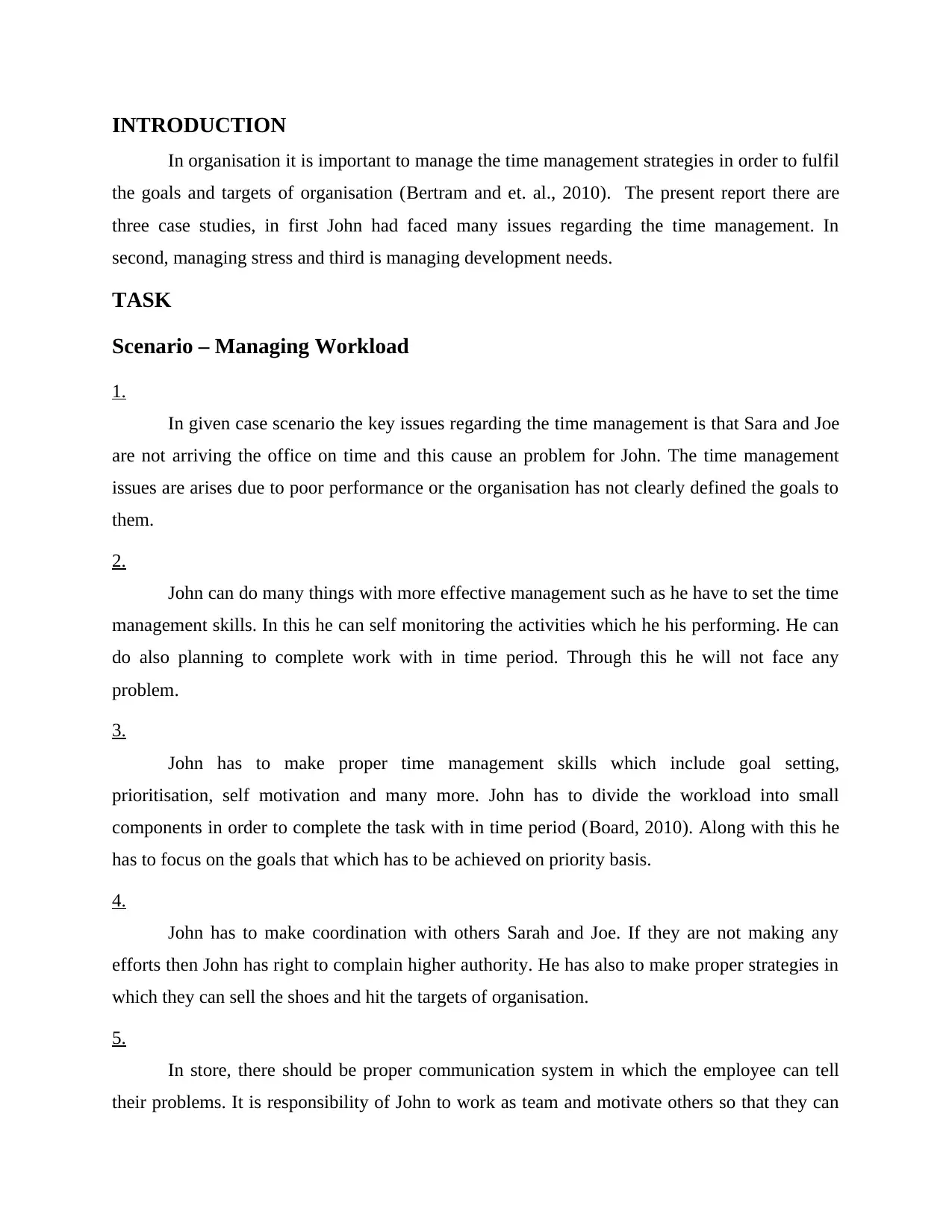
INTRODUCTION
In organisation it is important to manage the time management strategies in order to fulfil
the goals and targets of organisation (Bertram and et. al., 2010). The present report there are
three case studies, in first John had faced many issues regarding the time management. In
second, managing stress and third is managing development needs.
TASK
Scenario – Managing Workload
1.
In given case scenario the key issues regarding the time management is that Sara and Joe
are not arriving the office on time and this cause an problem for John. The time management
issues are arises due to poor performance or the organisation has not clearly defined the goals to
them.
2.
John can do many things with more effective management such as he have to set the time
management skills. In this he can self monitoring the activities which he his performing. He can
do also planning to complete work with in time period. Through this he will not face any
problem.
3.
John has to make proper time management skills which include goal setting,
prioritisation, self motivation and many more. John has to divide the workload into small
components in order to complete the task with in time period (Board, 2010). Along with this he
has to focus on the goals that which has to be achieved on priority basis.
4.
John has to make coordination with others Sarah and Joe. If they are not making any
efforts then John has right to complain higher authority. He has also to make proper strategies in
which they can sell the shoes and hit the targets of organisation.
5.
In store, there should be proper communication system in which the employee can tell
their problems. It is responsibility of John to work as team and motivate others so that they can
In organisation it is important to manage the time management strategies in order to fulfil
the goals and targets of organisation (Bertram and et. al., 2010). The present report there are
three case studies, in first John had faced many issues regarding the time management. In
second, managing stress and third is managing development needs.
TASK
Scenario – Managing Workload
1.
In given case scenario the key issues regarding the time management is that Sara and Joe
are not arriving the office on time and this cause an problem for John. The time management
issues are arises due to poor performance or the organisation has not clearly defined the goals to
them.
2.
John can do many things with more effective management such as he have to set the time
management skills. In this he can self monitoring the activities which he his performing. He can
do also planning to complete work with in time period. Through this he will not face any
problem.
3.
John has to make proper time management skills which include goal setting,
prioritisation, self motivation and many more. John has to divide the workload into small
components in order to complete the task with in time period (Board, 2010). Along with this he
has to focus on the goals that which has to be achieved on priority basis.
4.
John has to make coordination with others Sarah and Joe. If they are not making any
efforts then John has right to complain higher authority. He has also to make proper strategies in
which they can sell the shoes and hit the targets of organisation.
5.
In store, there should be proper communication system in which the employee can tell
their problems. It is responsibility of John to work as team and motivate others so that they can
⊘ This is a preview!⊘
Do you want full access?
Subscribe today to unlock all pages.

Trusted by 1+ million students worldwide
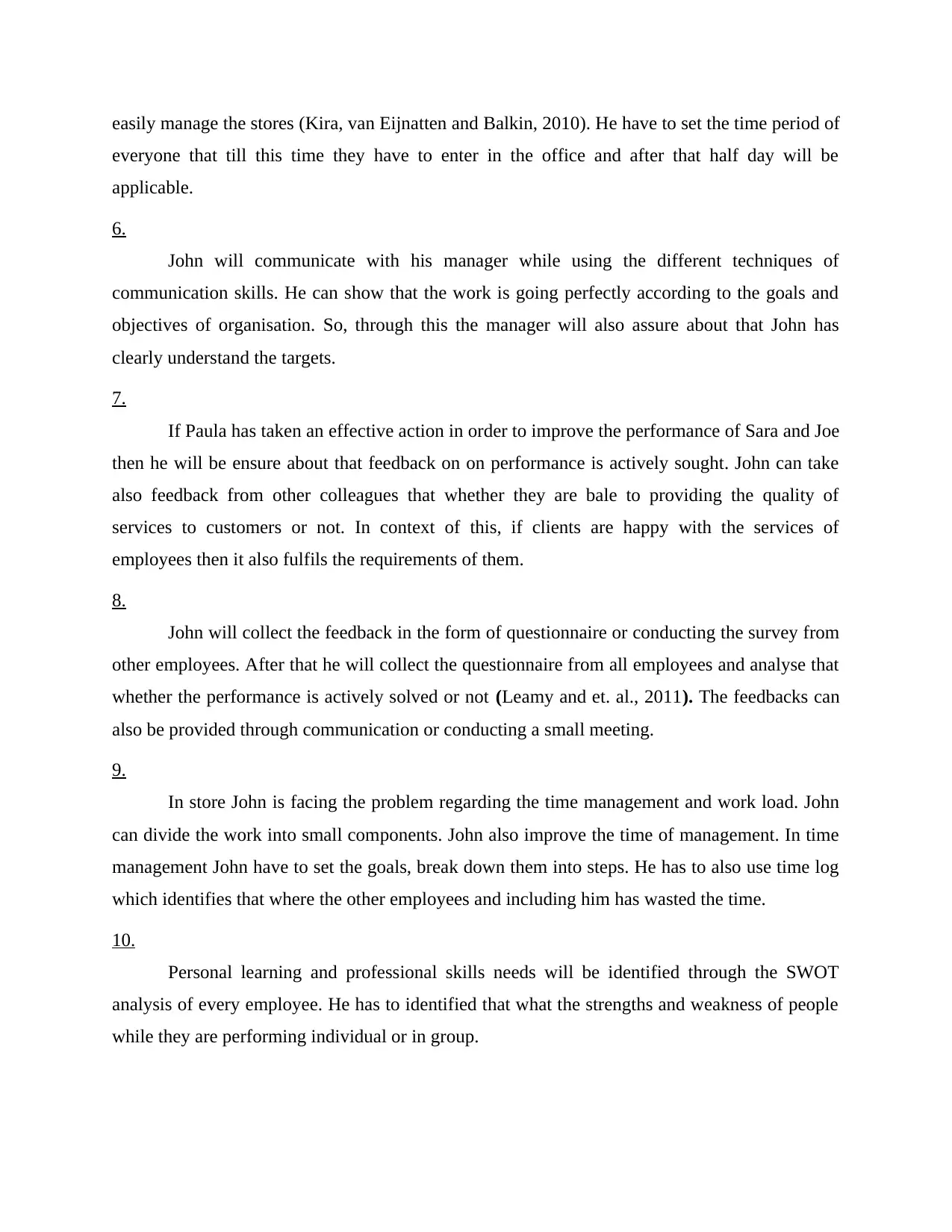
easily manage the stores (Kira, van Eijnatten and Balkin, 2010). He have to set the time period of
everyone that till this time they have to enter in the office and after that half day will be
applicable.
6.
John will communicate with his manager while using the different techniques of
communication skills. He can show that the work is going perfectly according to the goals and
objectives of organisation. So, through this the manager will also assure about that John has
clearly understand the targets.
7.
If Paula has taken an effective action in order to improve the performance of Sara and Joe
then he will be ensure about that feedback on on performance is actively sought. John can take
also feedback from other colleagues that whether they are bale to providing the quality of
services to customers or not. In context of this, if clients are happy with the services of
employees then it also fulfils the requirements of them.
8.
John will collect the feedback in the form of questionnaire or conducting the survey from
other employees. After that he will collect the questionnaire from all employees and analyse that
whether the performance is actively solved or not (Leamy and et. al., 2011). The feedbacks can
also be provided through communication or conducting a small meeting.
9.
In store John is facing the problem regarding the time management and work load. John
can divide the work into small components. John also improve the time of management. In time
management John have to set the goals, break down them into steps. He has to also use time log
which identifies that where the other employees and including him has wasted the time.
10.
Personal learning and professional skills needs will be identified through the SWOT
analysis of every employee. He has to identified that what the strengths and weakness of people
while they are performing individual or in group.
everyone that till this time they have to enter in the office and after that half day will be
applicable.
6.
John will communicate with his manager while using the different techniques of
communication skills. He can show that the work is going perfectly according to the goals and
objectives of organisation. So, through this the manager will also assure about that John has
clearly understand the targets.
7.
If Paula has taken an effective action in order to improve the performance of Sara and Joe
then he will be ensure about that feedback on on performance is actively sought. John can take
also feedback from other colleagues that whether they are bale to providing the quality of
services to customers or not. In context of this, if clients are happy with the services of
employees then it also fulfils the requirements of them.
8.
John will collect the feedback in the form of questionnaire or conducting the survey from
other employees. After that he will collect the questionnaire from all employees and analyse that
whether the performance is actively solved or not (Leamy and et. al., 2011). The feedbacks can
also be provided through communication or conducting a small meeting.
9.
In store John is facing the problem regarding the time management and work load. John
can divide the work into small components. John also improve the time of management. In time
management John have to set the goals, break down them into steps. He has to also use time log
which identifies that where the other employees and including him has wasted the time.
10.
Personal learning and professional skills needs will be identified through the SWOT
analysis of every employee. He has to identified that what the strengths and weakness of people
while they are performing individual or in group.
Paraphrase This Document
Need a fresh take? Get an instant paraphrase of this document with our AI Paraphraser
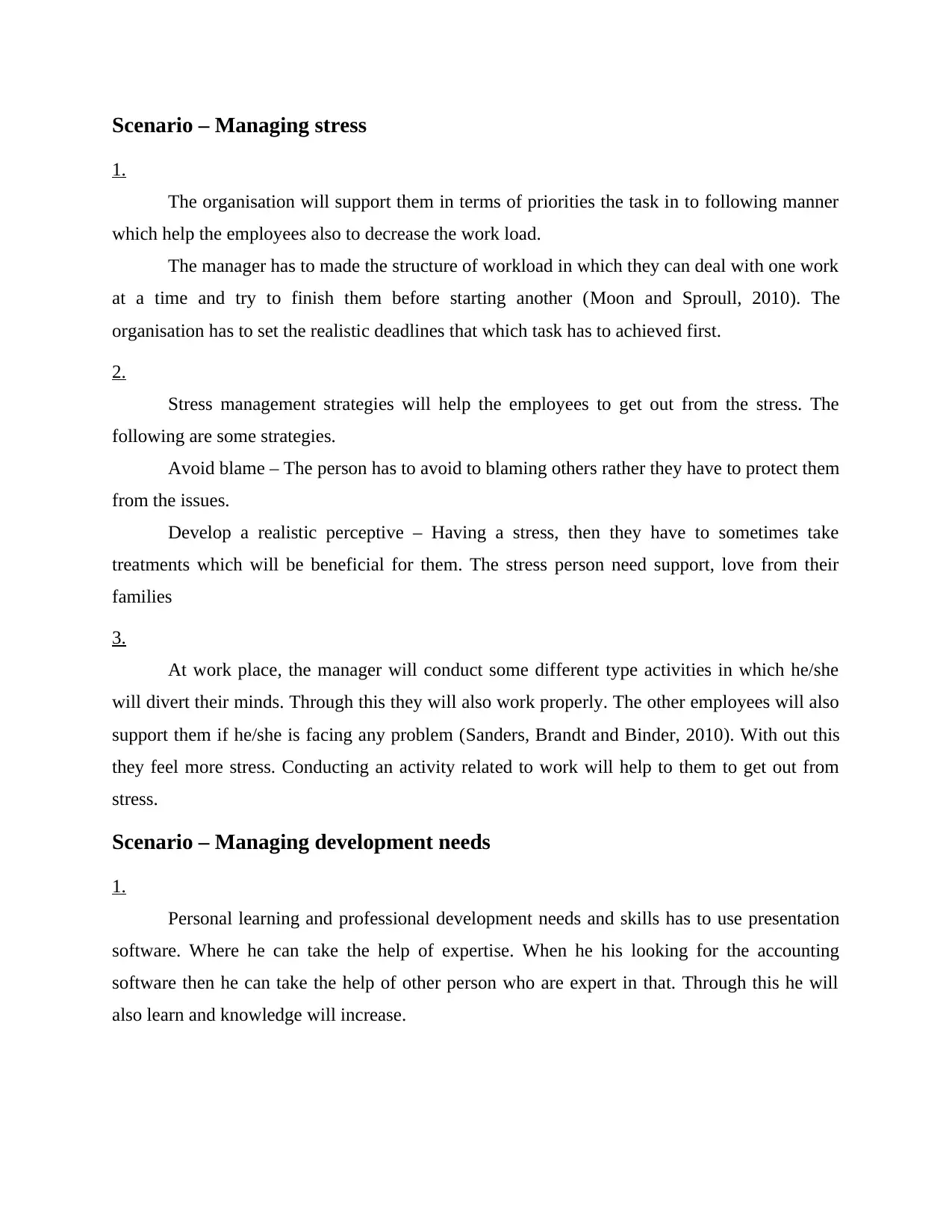
Scenario – Managing stress
1.
The organisation will support them in terms of priorities the task in to following manner
which help the employees also to decrease the work load.
The manager has to made the structure of workload in which they can deal with one work
at a time and try to finish them before starting another (Moon and Sproull, 2010). The
organisation has to set the realistic deadlines that which task has to achieved first.
2.
Stress management strategies will help the employees to get out from the stress. The
following are some strategies.
Avoid blame – The person has to avoid to blaming others rather they have to protect them
from the issues.
Develop a realistic perceptive – Having a stress, then they have to sometimes take
treatments which will be beneficial for them. The stress person need support, love from their
families
3.
At work place, the manager will conduct some different type activities in which he/she
will divert their minds. Through this they will also work properly. The other employees will also
support them if he/she is facing any problem (Sanders, Brandt and Binder, 2010). With out this
they feel more stress. Conducting an activity related to work will help to them to get out from
stress.
Scenario – Managing development needs
1.
Personal learning and professional development needs and skills has to use presentation
software. Where he can take the help of expertise. When he his looking for the accounting
software then he can take the help of other person who are expert in that. Through this he will
also learn and knowledge will increase.
1.
The organisation will support them in terms of priorities the task in to following manner
which help the employees also to decrease the work load.
The manager has to made the structure of workload in which they can deal with one work
at a time and try to finish them before starting another (Moon and Sproull, 2010). The
organisation has to set the realistic deadlines that which task has to achieved first.
2.
Stress management strategies will help the employees to get out from the stress. The
following are some strategies.
Avoid blame – The person has to avoid to blaming others rather they have to protect them
from the issues.
Develop a realistic perceptive – Having a stress, then they have to sometimes take
treatments which will be beneficial for them. The stress person need support, love from their
families
3.
At work place, the manager will conduct some different type activities in which he/she
will divert their minds. Through this they will also work properly. The other employees will also
support them if he/she is facing any problem (Sanders, Brandt and Binder, 2010). With out this
they feel more stress. Conducting an activity related to work will help to them to get out from
stress.
Scenario – Managing development needs
1.
Personal learning and professional development needs and skills has to use presentation
software. Where he can take the help of expertise. When he his looking for the accounting
software then he can take the help of other person who are expert in that. Through this he will
also learn and knowledge will increase.
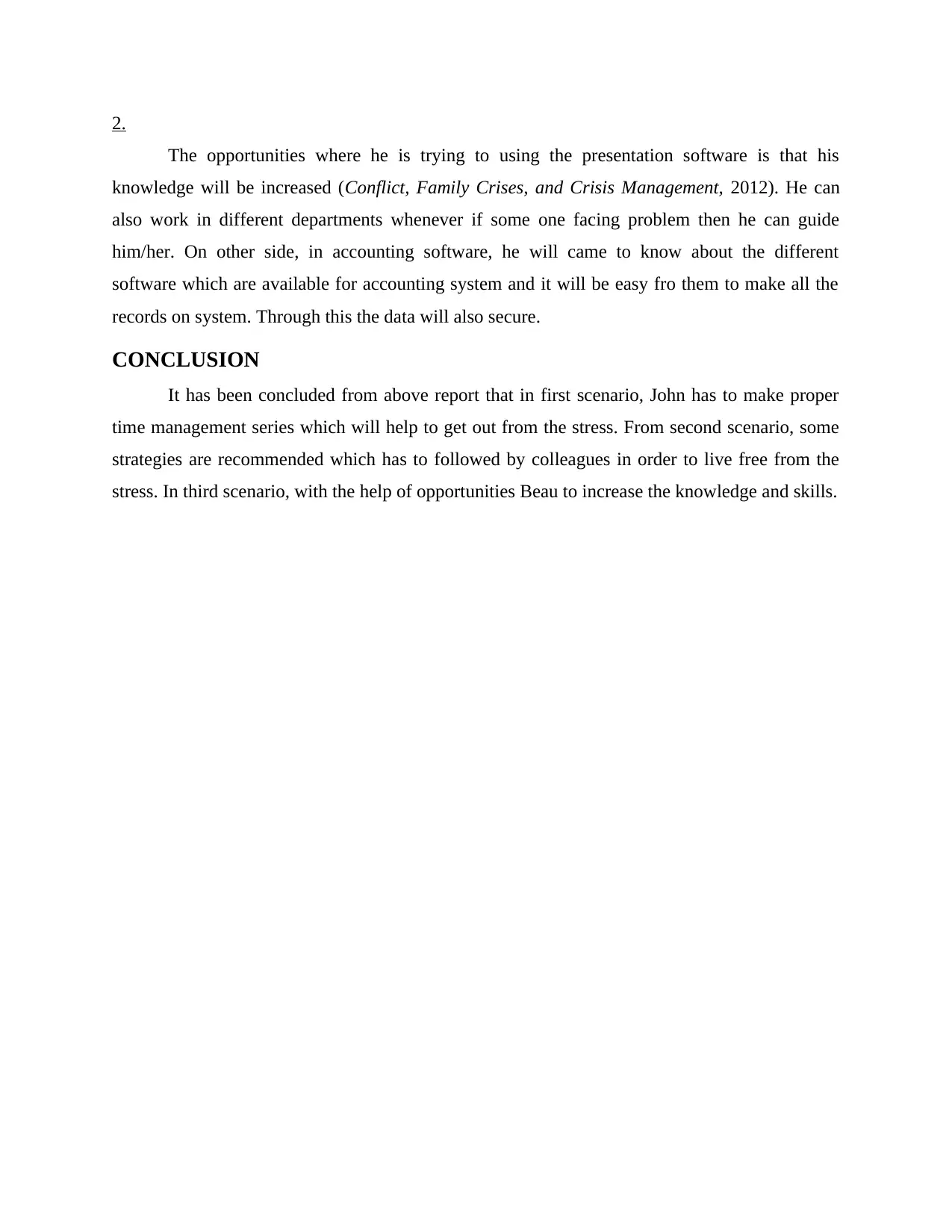
2.
The opportunities where he is trying to using the presentation software is that his
knowledge will be increased (Conflict, Family Crises, and Crisis Management, 2012). He can
also work in different departments whenever if some one facing problem then he can guide
him/her. On other side, in accounting software, he will came to know about the different
software which are available for accounting system and it will be easy fro them to make all the
records on system. Through this the data will also secure.
CONCLUSION
It has been concluded from above report that in first scenario, John has to make proper
time management series which will help to get out from the stress. From second scenario, some
strategies are recommended which has to followed by colleagues in order to live free from the
stress. In third scenario, with the help of opportunities Beau to increase the knowledge and skills.
The opportunities where he is trying to using the presentation software is that his
knowledge will be increased (Conflict, Family Crises, and Crisis Management, 2012). He can
also work in different departments whenever if some one facing problem then he can guide
him/her. On other side, in accounting software, he will came to know about the different
software which are available for accounting system and it will be easy fro them to make all the
records on system. Through this the data will also secure.
CONCLUSION
It has been concluded from above report that in first scenario, John has to make proper
time management series which will help to get out from the stress. From second scenario, some
strategies are recommended which has to followed by colleagues in order to live free from the
stress. In third scenario, with the help of opportunities Beau to increase the knowledge and skills.
⊘ This is a preview!⊘
Do you want full access?
Subscribe today to unlock all pages.

Trusted by 1+ million students worldwide
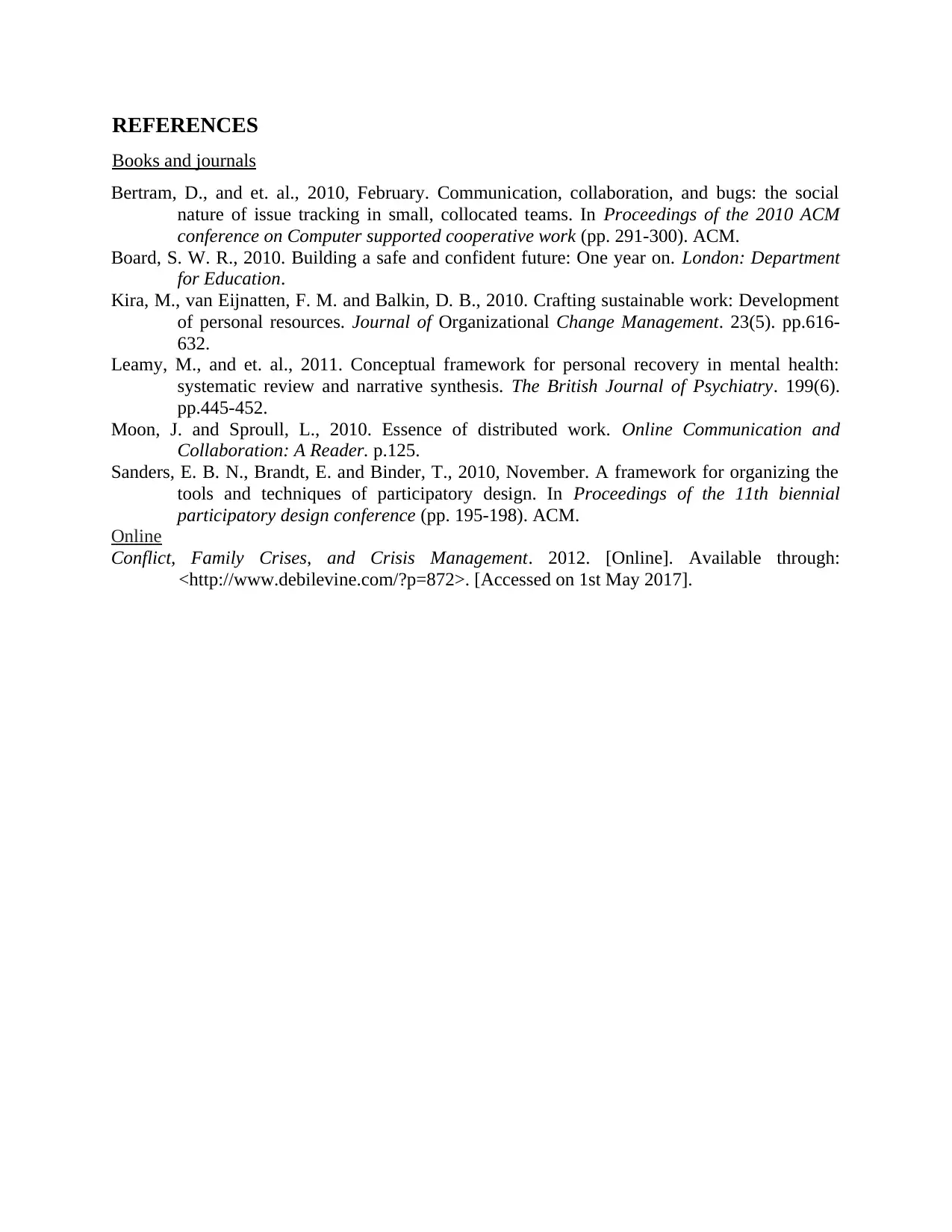
REFERENCES
Books and journals
Bertram, D., and et. al., 2010, February. Communication, collaboration, and bugs: the social
nature of issue tracking in small, collocated teams. In Proceedings of the 2010 ACM
conference on Computer supported cooperative work (pp. 291-300). ACM.
Board, S. W. R., 2010. Building a safe and confident future: One year on. London: Department
for Education.
Kira, M., van Eijnatten, F. M. and Balkin, D. B., 2010. Crafting sustainable work: Development
of personal resources. Journal of Organizational Change Management. 23(5). pp.616-
632.
Leamy, M., and et. al., 2011. Conceptual framework for personal recovery in mental health:
systematic review and narrative synthesis. The British Journal of Psychiatry. 199(6).
pp.445-452.
Moon, J. and Sproull, L., 2010. Essence of distributed work. Online Communication and
Collaboration: A Reader. p.125.
Sanders, E. B. N., Brandt, E. and Binder, T., 2010, November. A framework for organizing the
tools and techniques of participatory design. In Proceedings of the 11th biennial
participatory design conference (pp. 195-198). ACM.
Online
Conflict, Family Crises, and Crisis Management. 2012. [Online]. Available through:
<http://www.debilevine.com/?p=872>. [Accessed on 1st May 2017].
Books and journals
Bertram, D., and et. al., 2010, February. Communication, collaboration, and bugs: the social
nature of issue tracking in small, collocated teams. In Proceedings of the 2010 ACM
conference on Computer supported cooperative work (pp. 291-300). ACM.
Board, S. W. R., 2010. Building a safe and confident future: One year on. London: Department
for Education.
Kira, M., van Eijnatten, F. M. and Balkin, D. B., 2010. Crafting sustainable work: Development
of personal resources. Journal of Organizational Change Management. 23(5). pp.616-
632.
Leamy, M., and et. al., 2011. Conceptual framework for personal recovery in mental health:
systematic review and narrative synthesis. The British Journal of Psychiatry. 199(6).
pp.445-452.
Moon, J. and Sproull, L., 2010. Essence of distributed work. Online Communication and
Collaboration: A Reader. p.125.
Sanders, E. B. N., Brandt, E. and Binder, T., 2010, November. A framework for organizing the
tools and techniques of participatory design. In Proceedings of the 11th biennial
participatory design conference (pp. 195-198). ACM.
Online
Conflict, Family Crises, and Crisis Management. 2012. [Online]. Available through:
<http://www.debilevine.com/?p=872>. [Accessed on 1st May 2017].
1 out of 7
Related Documents
Your All-in-One AI-Powered Toolkit for Academic Success.
+13062052269
info@desklib.com
Available 24*7 on WhatsApp / Email
![[object Object]](/_next/static/media/star-bottom.7253800d.svg)
Unlock your academic potential
Copyright © 2020–2026 A2Z Services. All Rights Reserved. Developed and managed by ZUCOL.





